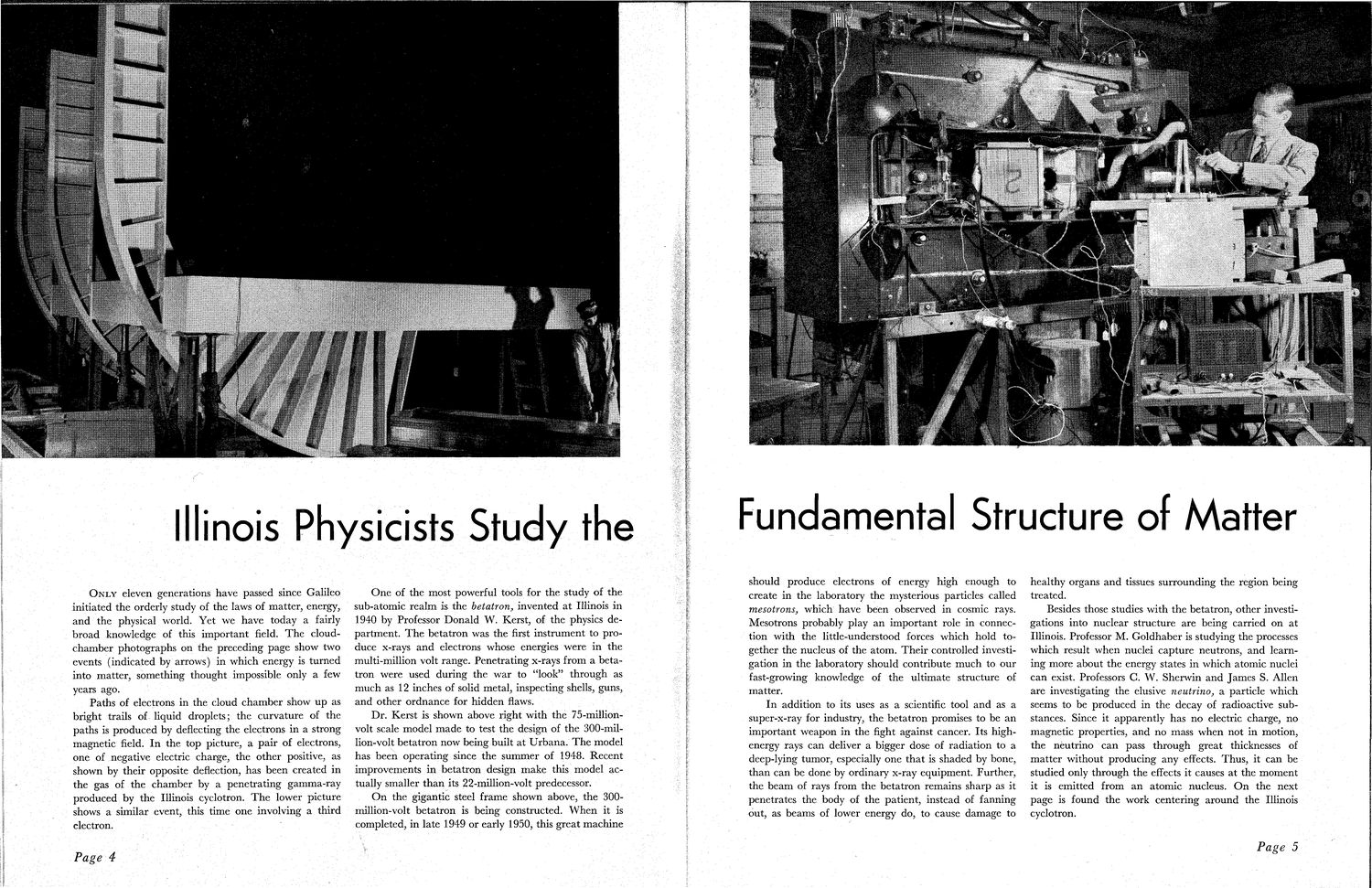| |
| |
Caption: Book - Research on Campus (1949)
This is a reduced-resolution page image for fast online browsing.

EXTRACTED TEXT FROM PAGE:
^^W^^^rajF- inois Physicists Study the O N L Y eleven generations have passed since Galileo initiated the orderly study of the laws of matter, energy, and the physical world. Yet we have today a fairly broad knowledge of this important field. T h e cloudchamber photographs on the preceding page show two events (indicated by arrows) in which energy is turned into matter, something thought impossible only a few years ago. Paths of electrons in the cloud chamber show up as bright trails of liquid droplets; the curvature of the paths is produced by deflecting the electrons in a strong magnetic field. In the top picture, a pair of electrons, one of negative electric charge, the other positive, as shown by their opposite deflection, has been created in the gas of the chamber by a penetrating gamma-ray produced by the Illinois cyclotron. T h e lower picture shows a similar event, this time one involving a third electron. One of the most powerful tools for the study of the sub-atomic realm is the betatron, invented at Illinois in 1940 by Professor Donald W. Kerst, of the physics department. T h e betatron was the first instrument to produce x-rays and electrons whose energies were in the multi-million volt range. Penetrating x-rays from a betatron were used during the war to "look" through as much as 12 inches of solid metal, inspecting shells, guns, and other ordnance for hidden flaws. Dr. Kerst is shown above right with the 75-millionvolt scale model made to test the design of the 300-million-volt betatron now being built at Urbana. T h e model has been operating since the summer of 1948. Recent improvements in betatron design make this model actually smaller than its 2 2-million-volt predecessor. O n the gigantic steel frame shown above, the 300million-volt betatron is being constructed. When it is completed, in late 1949 or early 1950, this great machine Fundamental Structure of Matter should produce electrons of energy high enough to create in the laboratory the mysterious particles called mesotrons, which have been observed in cosmic rays. Mesotrons probably play an important role in connection with the little-understood forces which hold together the nucleus of the atom. Their controlled investigation in the laboratory should contribute much to our fast-growing knowledge of the ultimate structure of matter. In addition to its uses as a scientific tool and as a super-x-ray for industry, the betatron promises to be an important weapon in the fight against cancer. Its highenergy rays can deliver a bigger dose of radiation to a deep-lying tumor, especially one that is shaded by bone, than can be done by ordinary x-ray equipment. Further, the beam of rays from the betatron remains sharp as it penetrates the body of the patient, instead of fanning out, as beams of lower energy do, to cause damage to healthy organs and tissues surrounding the region being treated. Besides those studies with the betatron, other investigations into nuclear structure are being carried on at Illinois. Professor M. Goldhaber is studying the processes which result when nuclei capture neutrons, and learning more about the energy states in which atomic nuclei can exist. Professors C. W. Sherwin and James S. Allen are investigating the elusive neutrino, a particle which seems to be produced in the decay of radioactive substances. Since it apparently has no electric charge, no magnetic properties, and no mass when not in motion, the neutrino can pass through great thicknesses of matter without producing any effects. Thus, it can be studied only through the effects it causes at the moment it is emitted from an atomic nucleus. O n the next page is found the work centering around the Illinois cyclotron. Page 4 Page 5
| |